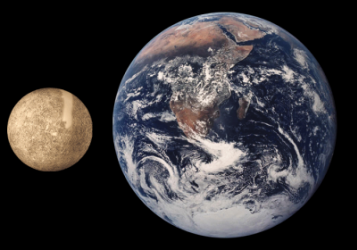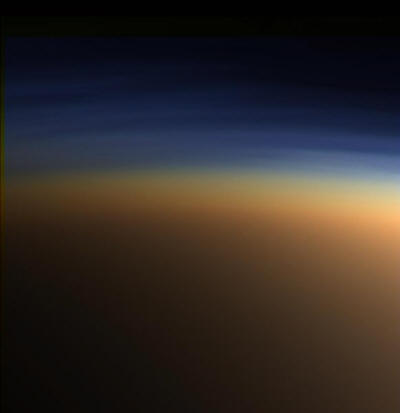Atmosphere
When we think of air, we often think of the specific chemical we need to breathe, namely oxygen. However, oxygen is not the only chemical in the air of Earth.
Dry air on Earth consists of approximately 78.08% nitrogen, 20.95% oxygen, 0.93% argon, 0.038% carbon dioxide. It also has trace amounts (that means small amounts) of other gases. Earth’s air also contains a variable amount (that means changing amount) of water vapor, on average around 1%.
When we think of these gaseous elements that we breathe, we typically call it “air.” But when we think of this very same air when it’s surrounding a planet, we call it the planet’s atmosphere!

The atmosphere of Earth
So why does the Earth have an atmosphere
while other planets like Mercury do not?
In actual fact, Mercury does have an atmosphere, it’s just a very, very thin one. It is so thin, in fact, that it does not protect the surface of Mercury from meteorites. On Earth, most meteorites burn up in our thick atmosphere, but this does not happen on Mercury. Moreover, since Mercury has such a thin atmosphere, it has n o weather patterns to wash away the evidence of impacts like the Earth. o weather patterns to wash away the evidence of impacts like the Earth.
The tiny atmosphere Mercury does have consists of 42% oxygen, 29% sodium, 22% hydrogen, 6% helium, and trace amounts of other chemicals.
Still, one can ask: why Mercury has such a thin atmosphere while the Earth has a thicker one?
Primarily, because the Earth is so much larger than Mercury.
Gaseous elements tend to be very light, and therefore they can easily float away. Because they can so easily float away, it takes much more gravity to hold gaseous elements down. Because Mercury is so much smaller than Earth, it has less gravity, and therefore has a much harder time retaining an atmosphere.
For Mercury, solar wind (i.e. a stream of charged particles ejected from the sun) can easily push away gases. Solar wind finds it much harder to do this to Earth, since Earth has a stronger gravity and is more capable at maintaining an atmosophere!
Does Mercury’s extremely weak atmosphere
have a large effect on its temperature?
In fact it does!
Temperature changes in bodies without atmospheres (or with extremely weak atmospheres such as Mercury) are very pronounced. For example, during the day Mercury’s surface reaches a temperature of 420º C, while at night it dips to −180º C.
Mars is smaller than the Earth, too.
Does it have an atmosphere?
Yes, it does. It is 95.32% carbon dioxide, 2.7% nitrogen, 1.6% argon, and has trace amounts of other chemicals. You can see the atmosphere of Mars below. 
Are there any moons in the solar system
that possess non-negligible atmospheres?
Indeed there are. Titan (a moon of Saturn) and Triton (a moon of Neptune) both possess non-negligible atmospheres consisting mostly of nitrogen.

Layers of haze in Titan’s atmosphere
Is Jupiter made entirely of atmosphere?
No. Although Jupiter (and the other Jovian planets) are called gas giants, they are not in fact in fact made entirely of gas.
Gas giants are commonly described as lacking a “solid surface,” although a more accurate description is to say that they lack a clearly-defined surface. Although they likely have rocky or metallic cores—in fact, such a core is thought to be required for a gas giant to form—the majority of the mass of Jupiter and Saturn is hydrogen and helium. In the planet’s upper layers, these elements are gaseous, as they are on Earth, but further down in the planet’s interior, they become compressed into liquids or solids, which become denser toward the core.

The dynamic atmosphere of Jupiter
(The atmosphere of Jupiter does not move this quickly in real life.)
Only that portion of Jupiter’s material that is in a gaseous state is considered its atmosphere.
Is it true that the very thin atmosphere
of the dwarf planet Pluto freezes?
Indeed it is. Pluto, in the nearer part of its orbit, has an atmosphere of nitrogen and methane similar to Triton’s, but these gases are frozen when farther from Sol.

Click here to return to the Astronomy Page.
Click here to return to the Kids Coяner.
|